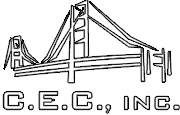The LADOTD awarded this contract to C.E.C., Inc. (C.E.C.) for major rehabilitation of the I-20 Mississippi River Bridge at Vicksburg.
The LADOTD determined that the structure’s main span had shortened due to rotation of one river pier.
Due to the pier movement, C.E.C. was required to make modifications to piers one & 2, struts, stringers, false chords, laterals, floor beams, and expansion dams. Replacement of the expansion bearings of piers E2 & E3 was also necessary.
Major components of the scope of work included:
- Drilling holes to stop cracks in webs
- Repair of false chords
- Re-welding of diaphragms
- Installation of jacking frame
- Finger joint modification
The primary emphasis of the I -20 project consisted of modifications to the bridge’s structure. In order to allow the main pier on the East (MS) side to move westward approximately 24 inches, changes included shortening an entire stringer span between floor beams and changing out three expansion joints, and then replacing them with a much larger expansion joint. Steel cover plates were used to carry traffic until new sections were poured and cured.
C.E.C. retrofitted the false chords and associated expansion devices, and, subsequent to this retrofitting process, C.E.C. used a jacking scheme that facilitated the suspended span into the bridge’s proper alignment. The jacking system allowed the bridge to be moved by four inches to the west while traffic continued to flow uninterrupted. Two of the main piers required an additional concrete section in order to jack the structure and install new slide bearings. The new slide bearings allowed the pier to slide longitudinally without causing bearing failure.
Numerous cracks and fractures to critical members were identified during inspections by using ultrasonic testing. C.E.C. repaired these cracks by drilling arrester holes and removed the existing paint with local containment. C.E.C. repainted areas where it had removed the existing coating.
The LADOTD required the bridge remain open to traffic at all times. One traffic lane in each direction was allowed to be closed for a maximum of four days per week. All vehicles lanes were required to be open the remaining days of the week and during holidays.
In order to maximize the use of manpower, C.E.C. developed a plan to use scaffolding and work platforms. The scaffolding and work platforms were erected on the underside of the bridge spans, thereby allowing work to continue seven days per week. The scaffolding and work platforms allowed for working space, storage, field office, and access to work areas underneath the bridge.
This project demonstrates C.E.C.’s ability to perform major repairs to a heavily traveled Interstate system while causing minimal disruption to traffic flow.






